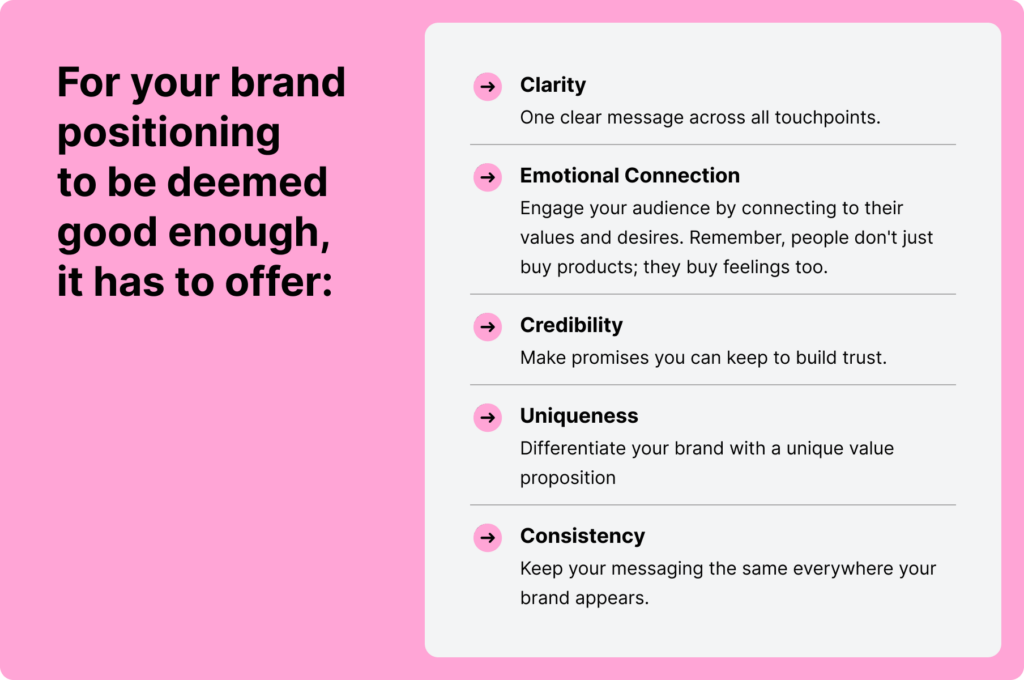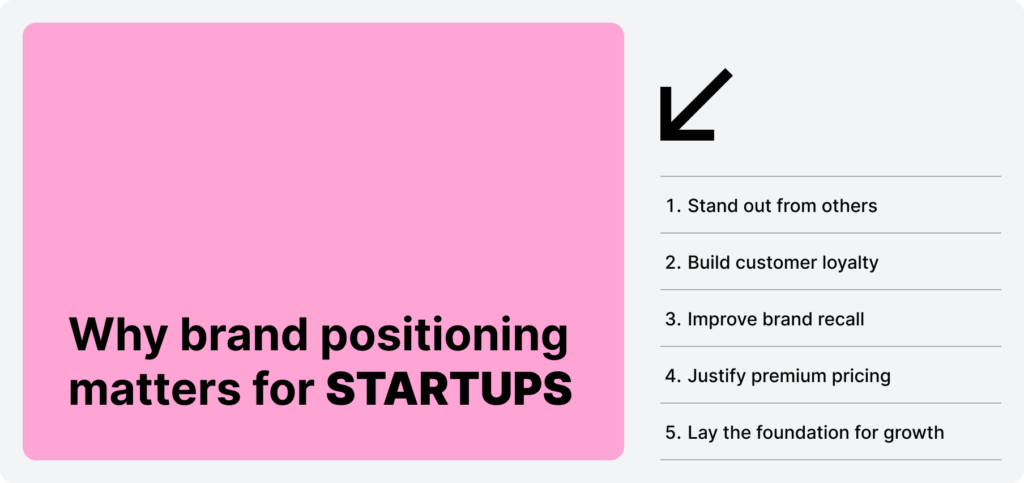How do you get noticed as a relatively new brand in a saturated market? The answer is simple: by making some noise! In this context, positioning your brand is the only noise that makes sense.
Brand positioning is crucial to any startup. It’s about creating a space for your brand in the minds of your target audience so it stands out in a crowded marketplace and builds trust and loyalty.
What is Brand Positioning?
Brand positioning defines how your brand is seen in the market and what differentiates it from competitors. It creates a unique identity that resonates with your target audience and tells them why they should choose your brand over others. Startups need a strong identity not just to stand out in a busy market but to attract the right audience and build trust from the get-go.

Examples of good brand positioning:
- Apple: Innovative, premium, user-friendly products.
- Tesla: Advanced technology and helping the environment for techies and those who care about sustainability.
- Coca-Cola: Happiness and moments of togetherness.

These examples show how clarity, emotional connection, credibility, uniqueness, and consistency can create an impression that sticks in customers’ minds. Applying these principles to startups can lay the foundation for long-term success and growth.
Why Brand Positioning Matters for Startups
We live in an era of information overload. Millions of messages, videos, and posts are created every minute. It’s a never-ending stream of data.
To be specific, in 2024,
- 8.5 billion searches happen on Google daily.
- E-commerce sales will surpass $6.3 trillion.
- Over 500 hours of video are uploaded to YouTube every minute, with an average of 70 billion views daily.
- Snapchat users generate over 5 billion snaps each day.
- The average person sends 72 text messages daily, about 23–27 billion in total.
- 361.1 billion emails are sent globally.
- An estimated 500 million tweets are sent daily on X.
But brand positioning helps you,

Stand Out From Others
Brand positioning shows your audience why you are different and better than others. In markets with similar products or services, having a clear message about what makes you unique gives people a reason to choose you.
Build Customer Loyalty
When your brand resonates with people through shared values or solving a specific problem, they feel a stronger connection to it. This connection builds loyalty and turns one-time buyers into repeat customers who trust and recommend your startup. Loyal customers are also more forgiving of mistakes and more likely to support your growth.
Improve Brand Recall
If, for instance, your startup offers fast and affordable home cleaning services, strong positioning will make customers think of you first when they need help with cleaning. Being memorable keeps your brand at the top of your audience’s mind and gets you repeat business.
Justify Premium Pricing
With strong positioning, customers see your brand as more valuable and are willing to pay more. This is how companies like Apple and Tesla can charge more. They’ve positioned themselves as leaders in quality and innovation. While your startup may need time to achieve this feat, it eventually can if you consistently communicate the value and benefits you offer.
Lay the Foundation for Growth
Good brand positioning gives your startup focus. It guides your marketing strategies, improves customer experiences, and makes your brand attractive to investors and partners. You’ll find it easier to scale and grow your business with a clear brand message.
How Exactly Does Brand Positioning Work?

Brand positioning covers several areas:
- Target Audience: Who are your ideal customers, and what do they value?
- Competitor Analysis: What are the gaps and opportunities in the market?
- Unique Value Proposition (UVP): What makes your startup unique?
- Clear Messaging: How do you communicate your value to your audience?
- Consistency: How do you reinforce your position wherever and whenever a customer interacts with your brand?
Steps to Build Your Startup Brand Positioning Strategy
Here is how to build your brand positioning:
Step 1: Figure Out Your Current Positioning
Start your brand positioning analysis by understanding how people see your brand today. Use surveys, interviews, or simple polls to gather customer feedback. Questions like, “What comes to mind when you think of our brand?” or “What do you wish we offered?” can be helpful here.Also, analyze your competitors’ positions to see where your brand can fill the gaps. Google Forms or SurveyMonkey can make collecting feedback easier.
Step 2: Define Your Target Audience
When you focus on specific personas, creating messages that attract them becomes easier. Remember, the goal is to connect with the right people, not everyone.
That’s why you must think about who your ideal customers are. Consider their age, job, daily habits, struggles, and interests. Then, describe them in detail. This helps you understand their needs and talk directly to them.
Step 3: Competitor Analysis
To find your place in the market, you need to understand your competitors. Research their strengths and weaknesses and how they connect with their audience. Look at their marketing strategies, brand messaging, and customer feedback.
Tools like SEMrush or SimilarWeb can help you analyze their online presence and find opportunities for your brand to stand out.
Step 4: Choose Your Brand Attributes
What do you want your brand to be known for? These attributes should align with your audience’s values and your business’s core strengths.
For example, if your audience values sustainability and innovation, include these in your messaging and offerings.
Step 5: Unique Value Proposition (UVP)
Your unique value proposition shows why your brand is the best choice and how you solve problems others cannot.
Make it clear and simple, so customers know why they should choose you.
Step 6: Make a Clear Positioning Statement
This statement should summarize your brand’s unique value in one or two sentences. It should be simple, memorable, and focused on what makes your startup unique.
A good positioning statement should be in a template like,
- “For [target audience], [your brand] is the [category] that [unique benefit].’
For example, “For tech-savvy professionals looking to simplify their work, Notion is the all-in-one workspace that helps them organize their thoughts, collaborate effortlessly, and boost productivity.”
Step 7: Test Your Positioning
Before finalizing your strategy, try it out on your target audience. Use surveys, focus groups, or direct interviews to gather feedback. Ask if the message resonates, feels authentic, and matches their needs. The information gathered from this process will help you refine and strengthen your positioning.
Step 8: Be Consistent
Your brand positioning should be visible in everything you do: your website, social media, ads, and customer service. Keep your message the same across all channels to make your brand memorable.
Get Professional Help
Branding, in general, and brand positioning, in particular, are a lot to handle. This is even more so for startups with limited resources.
Our team at Project Branding can save you time and get you results. Ready to position your startup for success? Contact us today!



